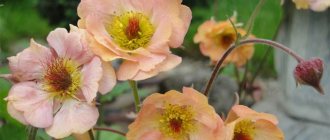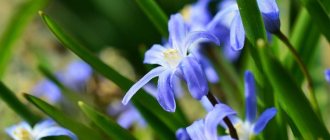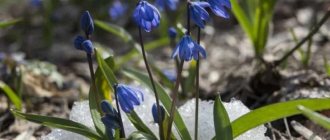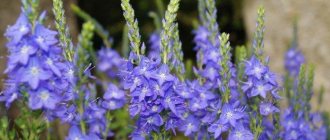Daylily is a beautiful flower that can decorate any place with its beauty. These flowers are now the most popular because of their hardiness. However, even such a modest plant requires proper care, especially during the period after flowering.
It is very easy to care for, easily takes root in any soil, and also quickly adapts to weather conditions. To grow a beautiful bush that will bloom profusely, you still need to create the most favorable conditions for the plant.
Daylily blossom
Planting and caring for daylilies in the open ground at the dacha
Among gardeners, daylilies are rightfully considered one of the most unpretentious and grateful perennials. If the garden is decorated with daylilies, planting and caring for them in the open ground will obviously not be a burden to the owner of the site.
Plants that love the sun do well in partial shade, the main thing is that the plants are actively illuminated for at least 6 hours. Daylilies do not have any special requirements for the composition of the soil and can grow and bloom in one place for many years, forming dense, lush clumps.
Yet, how to create the best conditions for growing these spectacular flowers? When to plant daylilies in open ground, in spring or autumn? How to care for plants at different times of the year?
Excess or lack of fertilizers
Many gardeners determine the reasons why daylilies do not bloom by the condition of the tops. Too much growth indicates an excess of nitrogen. Daylilies should be fed regularly, but without increasing the dosage. It is recommended to apply nitrogen-containing preparations in the spring, and to use potassium and phosphorus preparations in the summer-autumn.
Underfeeding a bush is just as bad as overfeeding.
Place for planting daylilies in the ground in spring
When choosing a site for a daylily, you need to take into account that the plants love the sun, are not afraid of the wind, and develop well where other ornamental perennials would feel oppressed. At the same time, for free growth, daylilies need freedom. They don’t like it when there are large plants, shrubs and trees nearby, which become a kind of competition for flowers for a place in the sun.
Experienced flower growers advise planting light varieties of daylilies in more illuminated places, and for purple, red, multi-color varieties, for which rich color is important, to look for areas with slight shading.
To simplify the care of daylilies after planting them in open ground, choose places for plants that are not flooded in the spring. In summer, powerful rhizomes of plants should not suffer from close groundwater.
Reproduction by offspring
What is special about the method? This method of breeding daylilies is one of the most difficult, since it requires adherence to a certain technology, but if you do everything correctly, you can grow a healthy plant that will retain all its species characteristics. The rosettes are pre-planted in pots or small containers and placed in a warm room for several weeks. Flowers move to open ground at the end of spring or about a month and a half before the onset of the first frost.
The best time to plant daylilies on the site
Daylilies are peculiar long-livers. The most beautiful flowers, forming clumps decorated with multi-colored corollas, they can grow for up to one and a half decades without replanting. This should be taken into account when choosing a place for plants in the garden, and you should also know that flowering will be at its most lush only for 5–7 years. Then flower stalks appear less frequently among the dense foliage, and the flowers on them are much smaller than before. Therefore, every few years the plants are replanted, dividing the mature perennials.
The unpretentious culture easily tolerates this procedure from early spring to autumn. But planting daylilies in the ground in the spring always goes without complications, the divisions quickly take root and grow, blooming in the same season.
Spring weather is changeable, and if there is a danger of frost, it is better to postpone planting. Planting material purchased or obtained after dividing your own plants can be stored for about a month, burying the root system of the plant in sand, peat-sand substrate, or transferring it with a damp rag. The leaf blades of daylilies are cut by half or a third to reduce the plant’s need for moisture.
If the summer is not hot, and it is possible to create comfortable conditions for daylilies when planting them in the ground, as in spring, nothing prevents you from decorating the garden until the fall. But when planting in autumn, there is a risk that the plants will not have time to take root well, and next year, if they survive, they will be very weakened.
How to plant daylilies in spring
Before transferring the seedlings to the garden, they need to be prepared for planting:
- Daylily cuttings are inspected and damaged, dry or rotten roots are removed.
- The sections are treated with charcoal or activated carbon crushed to a powder consistency.
- If this has not been done earlier, the foliage is cut 10–15 cm above the base of the leaf blades.
Often, planting material purchased in a store has dried out by the time the daylily is planted in open ground, and caring for such a plant begins with soaking the root system in a growth stimulator for 4 hours.
The location has been chosen, the planting material is waiting to be transferred to the ground. All that remains is to prepare soil suitable for daylilies and begin planting. Ornamental perennials prefer a loose, light substrate with a neutral or slightly acidic reaction.
Before planting daylilies in the spring, the soil at their future place of residence must be dug up with a shovel full. Next, make a planting hole large enough to accommodate the rhizomes. For more convenience:
- a cone of loosened substrate is poured at the bottom;
- a plant is placed on top of the soil;
- carefully lay out the rhizomes on the soil;
- sprinkle the underground part of the daylily with soil so that the root collar does not sink more than a couple of centimeters.
After planting is completed, the soil around is compacted a little and the daylily is watered.
To reduce moisture evaporation, the soil under the plants can be mulched using any available means, for example, rotted bark or pine needles, straw or specialized material.
Soil requirements
The daylily plant is not known for its whims. Almost any land suits him. For abundant flowering, it is advisable to normalize the soil to a comfortable state. The flower prefers a slightly acidic or neutral environment.
General recommendations for leveling the composition of the soil:
- It is advisable to dilute a dry sandy bed with clay.
- Excessively clayey soil is fertilized with compost with the addition of sand.
- The sod-podzolic composition is mixed with compost.
- You can use special mixtures for daylilies, which are sold in stores.
The ideal bed for daylilies is enriched loam with good drainage. If it is not possible to make a drainage system, then you can raise the bed.
Caring for daylilies after planting in open ground
Regular care of plants after planting consists of watering, loosening the soil and removing weeds.
In the warm season, actively growing and flowering perennials require a lot of water. If daylilies are thirsty, this can be noticed by fading foliage, failure to form, or dropping buds. Perennials respond excellently to additional air humidification in summer.
Therefore, daylilies can be planted near ponds or use very fine sprinkling:
- In hot weather, daylilies are watered abundantly, so that the soil under them gets wet by 20–30 cm, that is, to the depth of the root system.
- If the summer is not hot, you can reduce the frequency of watering, but you need to monitor the standing of the foliage.
The best time to water daylilies is early morning or evening, when there is no risk of sunburn on the flowers.
With proper planting and care, daylily flowers, as in the photo, appear in the same summer. In the first year, the plants are not additionally fed. The application of complex fertilizers for flowering ornamental crops begins next spring. When choosing a product, it is better to give preference to formulations with a moderate nitrogen content, which causes the growth of foliage to the detriment of flowering. During the summer, perennials are fed twice, and closer to autumn, the plants receive potassium-phosphorus fertilizers to better prepare for winter.
Dividing the bush
This method is the simplest and most effective, which is why most gardeners use it. The main advantage is that young plants retain the characteristics of the mother flowers. You can divide the bushes throughout the growing season. It is best to use daylilies for propagation that have reached three years of age. It is recommended to replant when the buds begin to decrease in size from year to year. The optimal time for division is late summer or early autumn.
When daylily blooms - how to care
Daylily is a beautiful flower that can decorate any place with its beauty. These flowers are now the most popular because of their hardiness. However, even such a modest plant requires proper care, especially during the period after flowering.
It is very easy to care for, easily takes root in any soil, and also quickly adapts to weather conditions. To grow a beautiful bush that will bloom profusely, you still need to create the most favorable conditions for the plant.
Daylily flowering period
Daylily is also known as hemerocallis or daylily. Hemerocallis – the Greek name of the plant comes from two words “hemera” (day) and “kallos” (beauty). This name fully describes the flower, because daylily blooms for a day, maximum two.
Note! Daylilies have nothing in common with lilies. These words are absolutely not synonyms. These are two different plants, daylily is rhizomatous, and lily is bulbous.
Daylily plant flowering time is from late June to August. Some hybrid varieties can bloom again. As a rule, after the first flowering they shoot arrows again.
When the daylily blooms, it is quite unpretentious, it easily tolerates weather changes: winds, rains, drought, temperature changes. Daylily loves moisture and sun. It is enough to plant the plant on the sunny side, not forgetting to water, it will definitely delight you with its unusual color.
Every gardener knows how many days a daylily blooms. The lifespan of one blossoming flower is one day. The garden where such flowers grow will not be empty because the flowers bloom one after another. There are a lot of inflorescences, sometimes their number reaches 20-25 pieces on a bush. Thanks to this, a picture of continuous, bright flowering is created. During the flowering period, daylily can produce 2-3 flowers per day, and in this case the composition will be even brighter.
When and in what month does daylily bloom? Regular varieties bloom in July, but some daylily hybrids can bloom in June or even May. This is usually characteristic of indoor daylilies.
Some gardeners note that the flower does not form buds. There may be several reasons:
- The young bush suffers from thickets of weeds. It is best to regularly weed the soil around the plant in the first year after planting. A little later, when the bush grows, it will no longer allow weeds to grow.
- Poor soil can also be the reason for the lack of flowers. Despite the fact that the plant is unpretentious, poor soil will not allow it to grow new buds. A little fertilizing in the spring with potassium, phosphorus, and in the fall with organic fertilizers will help avoid this trouble.
- Lack of sunlight and non-compliance with planting technology. Do not bury the plant too deeply in the ground.
Daylily that doesn't bloom
Additional Information! Despite the fact that the daylily is very hardy, it also sometimes needs additional care. Only in this case will it delight others with its beautiful flower shoots.
Description of the plant
Selection does not stand still, and it has not ignored daylilies. Initially, there were only 15 varieties, and they grew in the countries of the East and Central Europe. Now more than 35,000 hybrid forms have been bred, differing in color, stem length, flower size, petal and leaf structure.
Daylily, also called daylily, is a perennial plant with a long vertical stem topped with a cluster of bell-shaped or tubular flowers.
Its second name is derived from the phrase “beauty for a day,” which indicates the short life of the peduncle. However, do not rush to be disappointed - the same plant is capable of producing several buds in a row, which creates the impression of constant flowering.
In addition, different varieties of daylilies bloom at different times, so you can combine them so that flowering continues from late spring to late summer.
The timing of bud release is indicated on the plant packaging. They are:
- the earliest - flowering occurs at the end of May or beginning of June;
- early - bloom from the first days of July;
- medium - begin to awaken at the end of July;
- late - flowering occurs at the beginning of August.
One more nuance: the earlier the variety you choose, the shorter the time you will admire the flower. May and June varieties bloom for about 30 days, August ones - up to 65. The weather also dictates its conditions: if it is warm and sunny outside, the red flower blooms early, and the interval between it and the next is a day, but if the weather is cloudy and the air temperature is low , then the flowering interval increases by a day.
How daylilies bloom
Daylily is a herbaceous plant from the lily family. Some hybrid species, for example, the bulbous daylily, actually look like a lily with long linear leaves that can be curved.
The colors of the plant range from white, slightly yellowish to bright burgundy or brown. The pattern on the petals can also be different: stripes, strokes, spots. Some varieties have a bluish tint. On average, daylilies bloom within a month, but sometimes cloudy weather can extend this period.
Interesting! Professionals have more than 30 thousand varieties, different shapes, structures and patterns of daylilies. Decorative species are collected in bouquets in an arc or fan.
Based on flower shapes, the following varieties can be distinguished:
- terry - have up to 9 petals;
- spider has the widest petals with a ratio of 5:1;
- another variety is distinguished by unusually shaped flowers, and all other species can be classified as hybrid varieties.
There is a classification of plants by color. Here experts identify several large groups:
- orange - various variations of yellow, apricot and melon colors;
- yellow, gold - there are options with different edges, for example, terry with a corrugated edge;
- cinnamon combines several flowers of dark, brick colors;
- velvet plants have a deep, rich color;
- night and other dark shades (daylilies of dark red and purple colors);
- lavender, lilac - a separate large group with several types of varieties;
- almost white have a slight tint, either going into pink, yellow or peach.
Care during flowering
The plant can delight others with its beauty for almost a month, without requiring much attention at all. The plant loves moisture, but it should not be watered often. Thanks to its powerful root system, the flower retains water for a long time. The plant only needs watering during periods of severe drought, but even in this case, you should not overwater the plant because the roots may begin to rot.
During flowering, it is worth watering the plant only at the root, avoiding the leaves. This will allow the soil to become more saturated to retain moisture longer. The most suitable time for this is the evening, when the sun is not so active.
Properly feeding the plant means providing it with abundant flowering. The need for fertilizing depends on the quality of the soil. Sometimes once or twice a year is enough, and sometimes the procedure needs to be repeated several times.
It is important to know! It is better to under-fertilize than to overdo it. Excess fertilizer can greatly harm the flower.
Typically, the following types of feeding are distinguished:
- It is better to fertilize the plant with minerals in the spring as soon as the first leaves begin to grow. It is necessary to scatter dry granules between the bushes and planted flowers, and then sprinkle them with a rake.
- After flowering, it is necessary to fertilize the soil again. This will help the plant prepare to bloom next year. The quality, quantity and beauty of future buds will depend on feeding.
The soil should be well watered after fertilizing. You can lightly mulch the soil a couple of times a year. This will help prevent the soil from compacting around the roots. It is best to carry out this procedure using river sand. It is covered around the stem with a layer of 2-3 cm. Between the bushes you can mulch with peat. This simple procedure will protect the flowers from temperature changes.
Care after flowering
After flowering, plant care is also necessary. This will help the flower to bloom profusely next year. There are several simple rules for caring for daylilies after flowering:
- After the plant has finished blooming, you need to cut off the flower boxes. If you leave them, there will be much fewer flowers next time. It is best to cut them at the root, so the bush will not look too disheveled.
- Don't trim the foliage. If you leave the bush “naked”, it may not survive the winter and freeze.
- As a fertilizer after flowering, you should choose brands that do not contain nitrogen.
- Leave more space between planted bushes. This will make the flowers larger. The optimal distance will be 40-50 cm.
Daylily care after flowering
Daylily is very beautiful, but does not require thorough care. There are small recommendations, following which will help you grow a large bush with bright flowers on your site.
Weakened sickly plant
A representative of the flora weakened by disease attracts pests. The first step is to carefully examine the flower buds. It is in them that the largest concentration of unwanted guests occurs. Affected buds are removed and immediately destroyed. The use of special plant protection products will help get rid of diseases and pests, as well as keep the situation under control throughout the entire period of daylily growth and development.
Daylily - a flower of good luck in our gardens
Daylily (Hemerocallis) is a perennial herbaceous plant with bright, cheerful inflorescences in all shades of the rainbow. Its name comes from two Greek words: “hemera” - “day” and “kallos” - “beauty”, which is explained by the short life span of the beautiful flower, usually no more than one day. People call daylily a flower of joy and sincerely believe that touching it brings good luck and drives away all sorrows and sorrows.
This perennial withstands the vagaries of the Russian winter - temperature changes, winds, frosts. It is moisture-loving, unpretentious and loves the sun very much.
Beautiful daylily endures harsh Russian winters
The flowering time of daylilies varies depending on the species - from April to June. From the halo of its lush leaves, succulent peduncles strewn with funnel-shaped flowers stretch upward. Despite the fact that each of them lives only one day, this feature is almost invisible to the eye. After all, up to 50 buds can form on one peduncle, and more and more bloom every day. In total, it blooms for about a month, spreading around itself a subtle amber aroma with light notes of sandalwood. Some varieties bloom twice per season.
Daylily flower lives for one day
To achieve a decorative look in your garden from early summer to late autumn, plant different types of this flower side by side.











